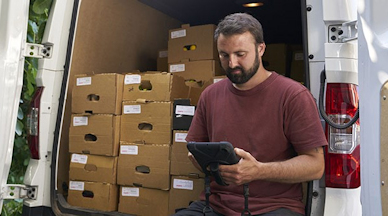
Smart solutions to fuel price volatility
Read time: 3 mins Added: 22/01/2024
While the prices at the pumps have fallen from the eye-watering levels we saw in 2022, they remain high and volatile. In December 2023, filling a car with either diesel or petrol would still set you back around £80.
Although you might expect certain types of businesses to be affected, like taxi firms or logistics businesses, the impact is actually felt much more widely.
Businesses counting the cost
Every business feels the pressure, whether through their supply chain, their own deliveries of goods and services, or even customers cutting back.
Fuel accounts for about a third of the running cost of haulage trucks, for example. Other transport sector businesses such as coach, bus and taxi firms are being squeezed. This is not only by rising fuel costs but by staff shortages, higher wage demands and the cost of investing in less carbon intensive fleets.
For those living and working in rural areas, rising fuel costs can be particularly damaging. A report from Leeds University Business School found that rural households are more dependent on their own vehicle, spending around £114 per week on transport alone. Farmers too faced increased costs, with prices of red diesel up about 30p per litre in 2023 compared to 2019 prices. The construction industry is also facing spiralling costs as surging fuel prices ramp up the costs of running key machinery.
But even sectors where fuel might not be considered a key cost factor, are feeling the effects of volatility. Employees struggling to fill their cars and managing the rising cost of living have been behind many of the demands for increases.
Smart solutions
Businesses are having to take tough decisions about whether to pass costs on to customers or even cut back journeys. But some are using smart tactics to help. These include:
Finding efficiencies
- Combining orders into one delivery means fewer journeys.
- Using technology to improve customer communications can help ensure that deliveries are right first time, or that someone is available to accept a delivery at a given time or can suggest a safe place where deliveries can be left.
- Using driver monitoring tools which can reward fuel-efficient driving.
Optimising transport logistics
- Creating hubs to store items nearer to their final destination to cut mileage.
- Sharing transport with other businesses so vans aren’t going out half full, or even working together so vans don’t return empty.
- Changing delivery charges for minimum order sizes.
- Shipping larger loads less frequently, rather than making multiple journeys with small deliveries, sometimes by incentivising customers to order more.
- Optimising routes so less mileage is needed, and less fuel used.
Sustainability bonus
Efficiencies like these not only help reduce mileage and fuel costs, they can have real benefits for boosting sustainability and help businesses move closer to reaching Net Zero.
For example, Mackie’s of Scotland boosted its production efficiency and reduced costs by investing in a moulding machine to make their own tubs on site rather than importing them all the way from Sweden. This cut transportation to the ice cream dairy from thousands of miles to just 200 metres.
Considering how to manage cost pressures in the short term through reviewing existing business models to identify opportunities for efficiency can be really important. But taking a more strategic look at whether investing in sustainability could bring wider and longer-term benefits can also help future-proof your business.